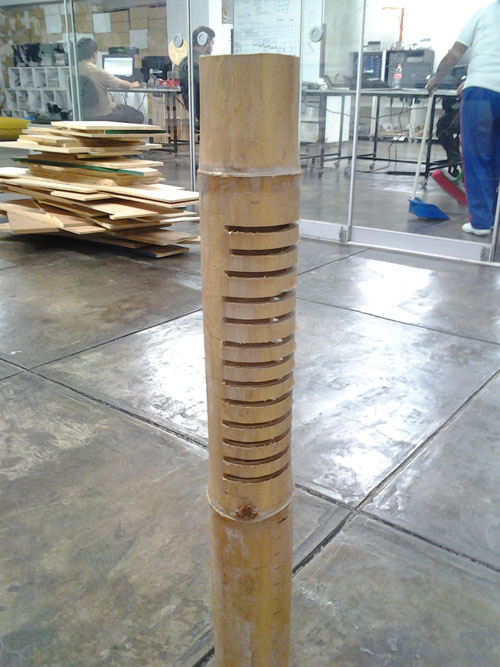Computer Controlled Machining
Link to class: Computer Controlled Machining
This week's assignment is to make something big. I decided to began incorporating the bamboo poles into my work and preparing a first draft on my final project. I'm trying to develop different types of "skins" for the urban space, but I won't be able to make such a big advance, so I've decided to narrow down my project to a single object I can manage and also apply all the amazing things I'm learning.
I designed a table made of MDF and Bamboo. What I've always wanted to make is to take the bamboo and make different forms with it, and see what can be done with the fablab in regards to that.
I took the bamboo poles and put them on the Shopbot and this is what happened:
Step ONE: Bamboo + Shopbot
On the Fab Academy 2012, Diego Machuca made some advances on cutting bamboo. But I wanted to make a step forward and integrating it to furniture. The hardest thing was to make the cuts on the bamboo with the Shopbot. To accomplish this I made a base with the shape of the bamboo and with some metal "u" shaped bards I managed to grab it to the base of the Shopbot.When cutting bamboo you need to place the bamboo first on the Shopbot, then measure it and put this measurements on the Autocad. For instance, I located my bamboo pole at approximate 285 mm from the X axis. So to make the cut I located my first line on this coordenate. What I want is to make the mill to made a single line to cut one half of the bamboo.

Then when configuring the Partworks software on Material you need the thickness to be the same as the diameter of the bamboo pole, in my case it was 90 mm.
After that, It's just about to configure the type of mill to use, type of cut and cutting depth.
I picked the lines, then went to Toolpaths operations > Create Profile Toolpath and configure as follows:
Cutting Depth
> Start Depth: 0,0 mm
> Cut Depth: 45 mm
Tool
> End Mill 6 mm
Machine Vectors
> ON
Direction
> Climb


Then I took it to the Shopbot software.
This software controls directly the Shopbot milling machine. The Shopbot need a key and a swtich to start. If the key or the switch are not on, you can't operate it. The key is connected by a cable to a wrench made for unscrewing the mills to change them. This is a safety measure. For starters, you should had to know how to change mills, which is farely easy if you have used a drill before.
I tried to make the cuts as close as possible. My idea was to put the MDF into this holes and use the bamboo pole to stabilize the furniture. Here is a video of the bamboo cutting in action. I need to warn you the NOISE is pretty disturbing, even though I already minimized it.
After that the MDF cuts were relatively easy. What I have to say is that the bamboo was very delicate after the cuts I've made, so maybe the use of a MILL is too hard for cutting the bamboo like this.

